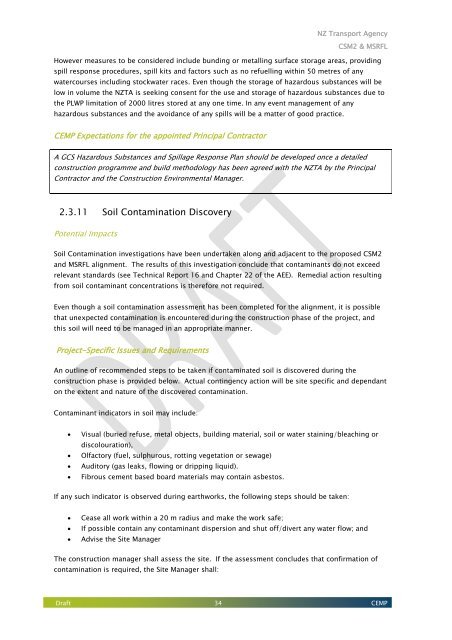CEMP - NZ Transport Agency
CEMP - NZ Transport Agency
CEMP - NZ Transport Agency
You also want an ePaper? Increase the reach of your titles
YUMPU automatically turns print PDFs into web optimized ePapers that Google loves.
<strong>NZ</strong> <strong>Transport</strong> <strong>Agency</strong><br />
CSM2 & MSRFL<br />
However measures to be considered include bunding or metalling surface storage areas, providing<br />
spill response procedures, spill kits and factors such as no refuelling within 50 metres of any<br />
watercourses including stockwater races. Even though the storage of hazardous substances will be<br />
low in volume the <strong>NZ</strong>TA is seeking consent for the use and storage of hazardous substances due to<br />
the PLWP limitation of 2000 litres stored at any one time. In any event management of any<br />
hazardous substances and the avoidance of any spills will be a matter of good practice.<br />
<strong>CEMP</strong> Expectations for the appointed Principal Contractor<br />
A GCS Hazardous Substances and Spillage Response Plan should be developed once a detailed<br />
construction programme and build methodology has been agreed with the <strong>NZ</strong>TA by the Principal<br />
Contractor and the Construction Environmental Manager.<br />
2.3.11 Soil Contamination Discovery<br />
Potential Impacts<br />
Soil Contamination investigations have been undertaken along and adjacent to the proposed CSM2<br />
and MSRFL alignment. The results of this investigation conclude that contaminants do not exceed<br />
relevant standards (see Technical Report 16 and Chapter 22 of the AEE). Remedial action resulting<br />
from soil contaminant concentrations is therefore not required.<br />
Even though a soil contamination assessment has been completed for the alignment, it is possible<br />
that unexpected contamination is encountered during the construction phase of the project, and<br />
this soil will need to be managed in an appropriate manner.<br />
Project-Specific Issues and Requirements<br />
An outline of recommended steps to be taken if contaminated soil is discovered during the<br />
construction phase is provided below. Actual contingency action will be site specific and dependant<br />
on the extent and nature of the discovered contamination.<br />
Contaminant indicators in soil may include:<br />
• Visual (buried refuse, metal objects, building material, soil or water staining/bleaching or<br />
discolouration),<br />
• Olfactory (fuel, sulphurous, rotting vegetation or sewage)<br />
• Auditory (gas leaks, flowing or dripping liquid).<br />
• Fibrous cement based board materials may contain asbestos.<br />
If any such indicator is observed during earthworks, the following steps should be taken:<br />
• Cease all work within a 20 m radius and make the work safe;<br />
• If possible contain any contaminant dispersion and shut off/divert any water flow; and<br />
• Advise the Site Manager<br />
The construction manager shall assess the site. If the assessment concludes that confirmation of<br />
contamination is required, the Site Manager shall:<br />
Draft 34 <strong>CEMP</strong>
















